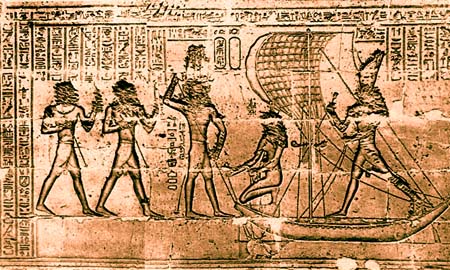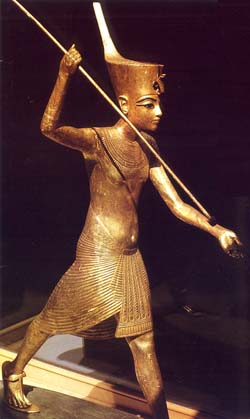
Feast of Victory

Horus harpooning the (very tiny) hippopotamus
of Seth in the
Edfu drama; from The Triumph of Horus
The Feast of Victory (probably called the Hab Nakhtet in Egyptian) was celebrated in the region of Edfu, in southern Egypt. What we know of the festival comes from the temple of Horus at Edfu built during the Ptolemaic Era, but evidence suggests that its observance reached back possibly to the Archaic Period. The Ptolemaic temple, today one of the most complete in Egypt, was built over the ruins of a New Kingdom temple that may itself have been built over older structures.
In ancient times the town was called Behdet (or Behedet), and was the center of worship for a form of Horus called Horus of Behdet. A solar deity, Horus of Behdet was most often pictured as a sun disk with outstretched wings. This refers to a local legend that Horus, as the son of Ra, took on the form of a sun disk with brilliantly-colored wings in order to swoop down on the enemies of Ra and destroy them. But according to the legend, which is inscribed on the walls of the Edfu temple, some of Ra's enemies escaped to join forces with Seth and took on the form of crocodiles and hippopotami. Horus and his followers pursued them with harpoons, ultimately destroying them.
It was this act of harpooning Seth and his confederates that was ritually dramatized in a passion play during the Feast of Victory. Celebrated in the second half of the second month of Peret (or Winter, corresponding to early January on our calendar), it also took place two months after the Osiris Mysteries and wove Osirian elements together with Horus's local personality as the "Behdetite". In what was probably an intensely cathartic ceremony of ritualized violence, a hippopotamus effigy (or perhaps a real one--scholars aren't sure!) was harpooned by officiants representing Horus, Isis, and the Followers of Horus (the Horu Shemsu). A hippo cake was cut up and distributed to be eaten by participants. Scholars theorize that the act of eating a representation of Seth was symbolic of absorbing and subduing his powers.
Scholars analyzing reliefs in the courtyard of the Edfu temple, such as the one pictured above, have surmised that the accompanying texts record dialogue and stage directions of the ancient drama. Using this format, the translated texts have actually been performed in a few college theatrical productions in Britain, Canada and the United States since the early 1970's. You can actually see a slide show of a 2000 production at the College of Charleston here. They also list line drawings of individual scenes from the temple on this page.
Of course, this festival wasn't terribly friendly to Seth, who was worshipped as a god of strength and prestige in other parts of the country! By the Ptolemaic Era, Seth's reputation was certainly at an ebb; but during earlier parts of Egyptian history when Seth still had active ahderents, the Feast of Victory was also being celebrated at Edfu. Our best example of this comes from Tutankhamun's tomb, and the famous statue of him as Horus with an upraised harpoon (see below). He may have actually been present for the annual festival during his lifetime, embodying the young Horus just as his statue immortalizes him. The real puzzle for us to decipher in the modern day is how Tutankhamun and his people harmonized very anti-Seth religious traditions such as the Feast of Victory with the traditions of those who worshipped Seth's less threatening aspects.

Sources: H. W. Fairman. The Triumph of Horus: An Ancient Egyptian Sacred Drama. London, 1974.
Gilbert, et al. Treasures of Tutankhamun. New York, 1976.
Back to Temple Main Page